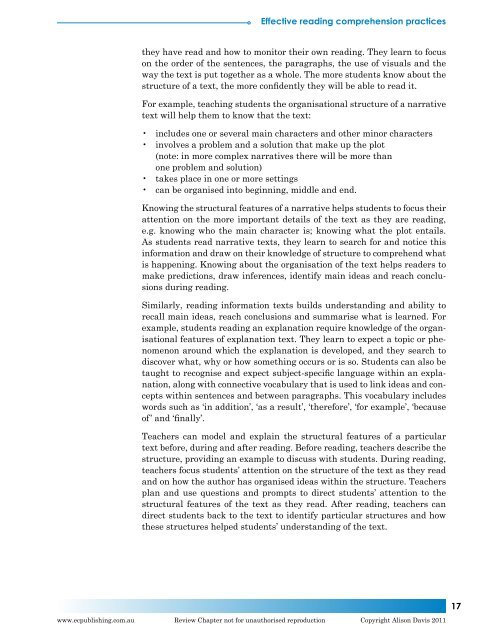Chapter 1: Effective reading comprehension practices (PDF)
Chapter 1: Effective reading comprehension practices (PDF)
Chapter 1: Effective reading comprehension practices (PDF)
Create successful ePaper yourself
Turn your PDF publications into a flip-book with our unique Google optimized e-Paper software.
<strong>Effective</strong> <strong>reading</strong> <strong>comprehension</strong> <strong>practices</strong>they have read and how to monitor their own <strong>reading</strong>. They learn to focuson the order of the sentences, the paragraphs, the use of visuals and theway the text is put together as a whole. The more students know about thestructure of a text, the more confidently they will be able to read it.For example, teaching students the organisational structure of a narrativetext will help them to know that the text:• includes one or several main characters and other minor characters• involves a problem and a solution that make up the plot(note: in more complex narratives there will be more thanone problem and solution)• takes place in one or more settings• can be organised into beginning, middle and end.Knowing the structural features of a narrative helps students to focus theirattention on the more important details of the text as they are <strong>reading</strong>,e.g. knowing who the main character is; knowing what the plot entails.As students read narrative texts, they learn to search for and notice thisinformation and draw on their knowledge of structure to comprehend whatis happening. Knowing about the organisation of the text helps readers tomake predictions, draw inferences, identify main ideas and reach conclusionsduring <strong>reading</strong>.Similarly, <strong>reading</strong> information texts builds understanding and ability torecall main ideas, reach conclusions and summarise what is learned. Forexample, students <strong>reading</strong> an explanation require knowledge of the organisationalfeatures of explanation text. They learn to expect a topic or phenomenonaround which the explanation is developed, and they search todiscover what, why or how something occurs or is so. Students can also betaught to recognise and expect subject-specific language within an explanation,along with connective vocabulary that is used to link ideas and conceptswithin sentences and between paragraphs. This vocabulary includeswords such as ‘in addition’, ‘as a result’, ‘therefore’, ‘for example’, ‘becauseof’ and ‘finally’.Teachers can model and explain the structural features of a particulartext before, during and after <strong>reading</strong>. Before <strong>reading</strong>, teachers describe thestructure, providing an example to discuss with students. During <strong>reading</strong>,teachers focus students’ attention on the structure of the text as they readand on how the author has organised ideas within the structure. Teachersplan and use questions and prompts to direct students’ attention to thestructural features of the text as they read. After <strong>reading</strong>, teachers candirect students back to the text to identify particular structures and howthese structures helped students’ understanding of the text.17www.ecpublishing.com.au Review <strong>Chapter</strong> not for unauthorised reproduction Copyright Alison Davis 2011


